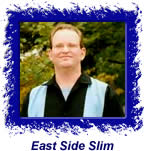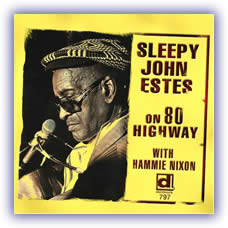 By
East Side Slim By
East Side Slim
 Sleepy
John Estes with Hammie Nixon – On 80 Highway Sleepy
John Estes with Hammie Nixon – On 80 Highway
Delmark, 2008
Sleepy John Estes, supposedly that nickname due
to his ability to sleep while standing up, was born
in the Brownsville, TN area around 1904. He recorded
for a number of record labels over the course of
six decades, starting in 1929 and continuing sporadically
into the 1970s. His style of music was always down-home,
and he relied upon his expressive voice to put his
music over rather than on guitar showmanship. Estes
was never considered an exemplary guitarist.
Hammie Nixon was also born into the Brownsville,
TN area (1908). He too began his professional career
in the 1920s, playing harmonica. Nixon helped to
pioneer the use of the harp as an accompaniment
instrument. Prior to this, the harp had been used
primarily as a soloing instrument. Hammie played
in several jug bands, working on kazoo, guitar and
jug in addition to harp. Nixon and Estes played
together on and off from the 1920s until Estes’
death in the late 1970s.
Sleepy John was 70 when this CD, On 80 Highway,
was recorded back in 1974. His singing voice was
not very strong by this time, sounding all of 70.
Hammie was around 66 years old then, but his voice
was still very strong – he sings on many of
the cuts on this CD. There is nothing fancy musically
to be found on this CD. It is all played back-porch
style, with simple song structures, acoustic guitar,
acoustic harmonica and some kazoo. This is very
much in the pre-war style the two men are known
for, and the music here will grow on you with repeated
listens. While this is a good representation of
how Estes and Nixon sounded in their later years
(it’s very well recorded and remastered),
it is not the place to start if you are just exploring
Sleepy John’s and Hammie’s music.
The
Songs: (all songs traditional from public
domain except where noted)
1.
Love Grows In Your Heart
--There isn’t anything fancy here. It’s
a strictly acoustic performance from Sleepy John
and Hammie, with Sleep John only strumming chords
on guitar and Hammie fluttering his harp in his
usual manner. Estes sings the vocal on this track.
While it is a simple tune, the true beauty lies
in the lyric. It speaks to a universal truth, of
letting love grow and rule your life, pushing away
the darkness and hate.
2.
Potatoe (sic) Diggin’ Man
--This tune is a down-home track sung by Hammie,
using the potato diggin’ metaphor for sexual
prowess. Hammie’s voice works well on this
track, as it does on all the cuts he sings on. He
had a powerful voice that has lost little of its
power at the time of this recording.
3.
Talk
--This is a little joke telling session between
Sleepy John and Hammie. It can be a little tough
to understand everything the men are saying, as
it will take you a couple listens to catch-on to
their speaking dialect – that and the fact
that both men talk incredibly quickly.
4. I’ll Be Glad When You’re
Dead – (Sam Theard)
--The talk of track 3 leads directly into this song,
which is likely better know to many readers as You
Rascal You. Sleepy John sings here, strumming along
on guitar a little more vigorously than on the 1st
couple of songs. Hammie puts the harp down and instead
serenades us with kazoo.
5. Holy Spirit
--The title of this song is self-explanatory. The
men both sing on this old spiritual, with Hammie
singing a lead line and Sleepy John answering with
a response line. The only instrumentation heard
through most of the tune is John’s guitar,
with Hammie adding some harp near the end.
6. 80 Highway
--This tune carries the same melody familiar to
many of you as Since You Left Me Baby. Sleepy John
carries all the singing here (which isn’t
necessarily a good thing, as he voice hadn’t
aged especially well at this point), and Hammie
accompanies throughout on harp. This is a nice gentle
tune, which Hammie’s harmonica playing carries
along.
7. When The Saints Go Marching In
--This could very well be the most subdued version
of this song you’ve ever heard. Usually associated
with a brass band, or at least a couple of horns,
the men take the song and turn it into a back-porch
affair. That said, the more subdued arrangement
places much greater emphasis on the lyric to this
tune, which is about seeing Jesus and your loved
ones (again) upon reaching Heaven. Personally, I
think this version carries much greater weight than
the brassed-up versions, which many times turn into
dance tunes. Now, I’m not saying you can’t
have religious tunes combined with dancing, retaining
the meaning of the lyric. You most certainly can!
8. Corrine Corrina – (Williams/Chatman/Parish)
--Both men sing here, with Sleepy John calling and
Hammie responding. Hammie’s kazoo is brought
out again, too. While 3 men were credited with songwriting
credits, I’m wondering if anyone truly knows
who the original composer of Corrine Corrina was…
9.
President Kennedy (take 14)
--Holy cow, fourteen takes! Sleepy John and Hammie
couldn’t have been happy about that. Many
blues artists composed and sang songs about President
Kennedy upon his assassination. Kennedy was looked
on with great hope by the African American community
in general, as he seemed genuinely intent on pushing
forward Civil Rights issues. This is a deep track,
with the focus on lyrical content. Instrumental
backing is sparse and respectful.
10.
IGA
--This tune has Sleepy John singing and strumming,
with Hammie playing harp. Sleepy John’s woman
seems to be looking a little too closely at a man
who works down at the local IGA grocery –
and John is not happy about it.
11.
T Model Ford
--no, this tune is not about Fat Possum artist T-Model
Ford. What this tune is about is Henry Ford’s
T Model Ford, and how Sleepy John prefers the old
T Model over all the fast cars flying around the
roads later on. No matter what happened, it only
took 2 men to set the T Model Ford back on the road,
and off you go again.
12.
Do Lord Remember Me
--Hammie takes the lead vocal work on this old spiritual
song. His stronger voice was much better suited
to this type of material than was Estes’ voice.
Sleepy John strums along and provides response lines
to Nixon’s lead, and hand-claps were used
here for rhythm.
13.
Vernita Blues
--This is one of those deep, deep blues, sung by
a man when he’s having a tough time with his
woman. Sleepy John sings this, and plays guitar
a little harder than on most of the tracks on this
album. Hammie is using his harp to wail along behind
Sleepy John, raising and lowering his volume for
dramatic effect. This could very well be the best
track on the CD, and it is my favorite for sure.
14. Mary Come On Home – (John Adam
Estes)
--Estes sings this track, also, and he seems to
be playing with added vigor here, too. This song
is very similar in style to Vernita Blues, although
the tempo is quicker. The melody is not too different
from some of the tunes of John Lee “Sonny
Boy” Williamson, who was from the same general
area of Tennessee as were Sleepy John and Hammie.
15. President Kennedy (take 13)
--This take of the song is quicker than take 14
(heard earlier on the CD), and not as melancholy.
The lyric is sung to what is essentially the melody
from Worried Life Blues. Sleepy John sings here,
with Hammie playing harp.
16. Talk
--More talk, Hammie talked so fast I can hardly
keep up with him. Here he’s telling a story
about threatening to cut a man who keeps messing
with him, leading into talking about a woman who
owned him $20 bucks that may be facing the business
end of Hammie’s shotgun
17. Brownsville Blues – (John Adam
Estes)
--The set closer, this is a performance of Sleepy
John’s tune, 1st recorded in 1929. At least
that’s what they tell us at the beginning
of the cut. Brownsville, Tennessee was Estes’
home town, and this song details some of his experiences
living there. The tune is very definitely down-home
in style, about as down-home as you can get. Sleepy
John is singing, almost hitting the guitar string
(rather than strumming), and Hammie Nixon is playing
very simplified harp chords and notes.
The Verdict:
This
CD, On 80 Highway, is a good representation of how
Sleepy John Estes and Hammie Nixon sounded during
their later years – Sleepy John was 70 when
this was recorded back in 1974, and Hammie was only
4 years younger. The sound quality of the CD itself
is very good; however, John’s voice was getting
weak by this time and his guitar playing consisted
mostly of chording. Hammie’s voice was still
very strong, and his harp work was still in very good
shape. This is not the place to start when listening
to Sleepy John and Hammie (you need to go back several
decades for that), but it is a nice back-porch style
album, and a fine document of two legendary bluesmen
in their later years. I’m going to give this
CD an STLBluesometer rating of 3.00
Lee
Howland - aka
"East Side Slim"
|
